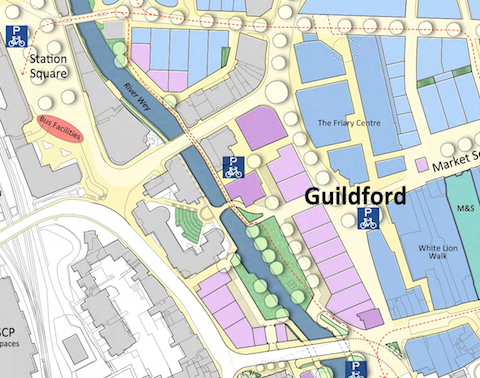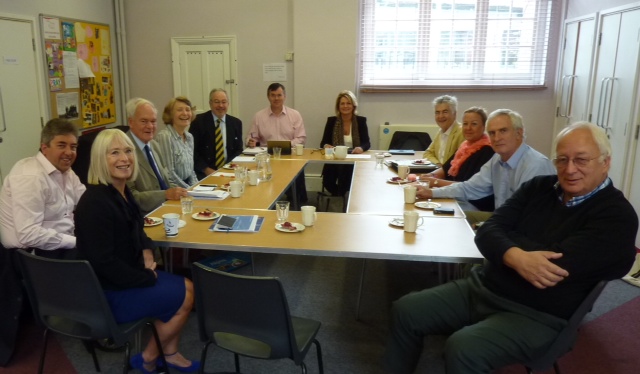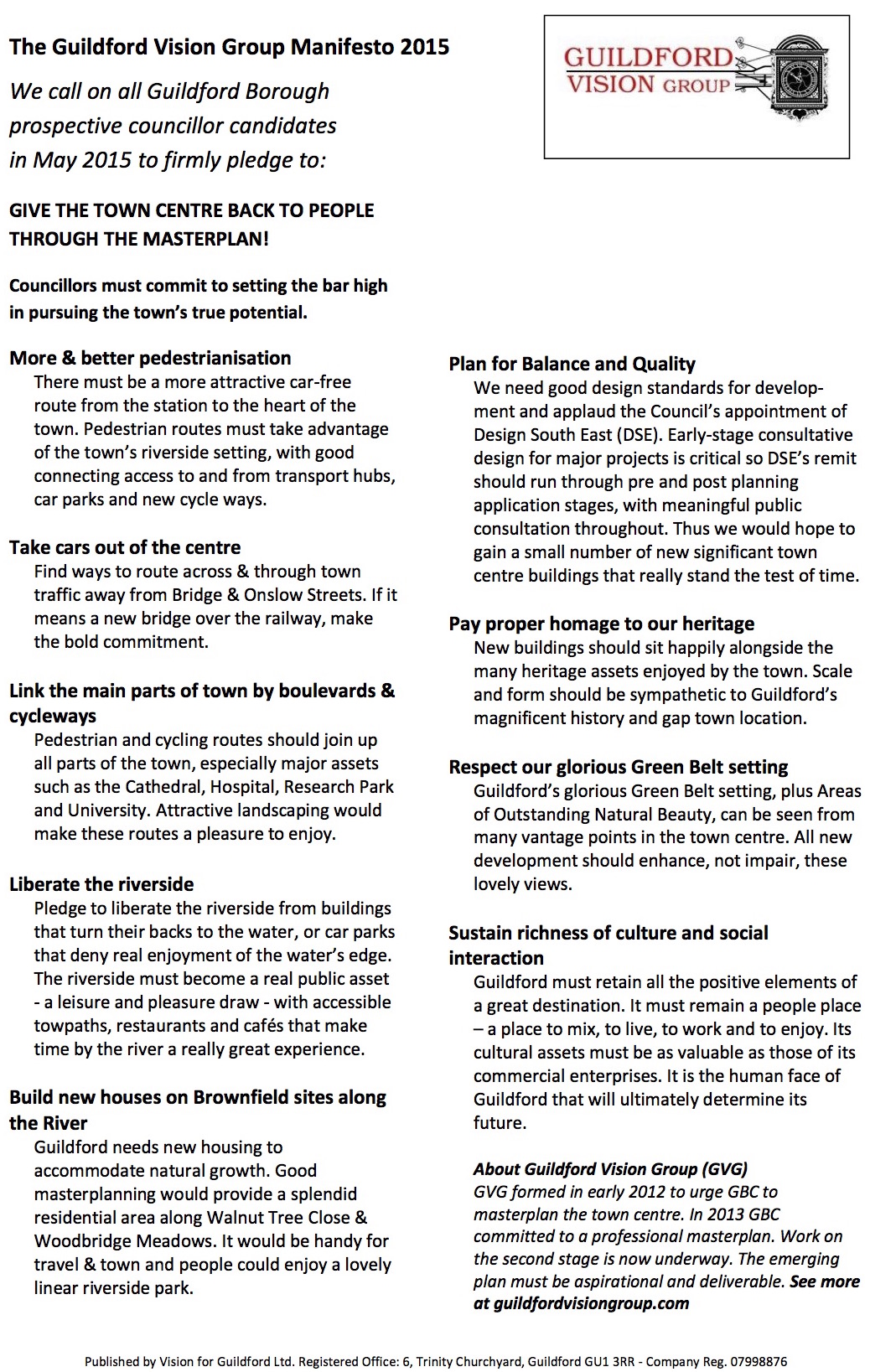 Abraham Lincoln
If given the truth, the people can be depended upon to meet any national crisis...
Abraham Lincoln
If given the truth, the people can be depended upon to meet any national crisis...
 Guildford news...
for Guildford people, brought to you by Guildford reporters - Guildford's own news service
Guildford news...
for Guildford people, brought to you by Guildford reporters - Guildford's own news service
Vision Group Reveals Its Masterplan and ‘Manifesto’ for Guildford
Published on: 17 Apr, 2015
Updated on: 18 Apr, 2015

An extract of Guildford Vision Group’s masterplan showing, near the bottom of the image, the town bridge which would be re-opened to motor vehicles. The circular symbols represent trees that will be planted along pedestrian priority routes.
The Guildford Vision Group (GVG) has revealed, exclusively to The Guildford Dragon NEWS, its draft masterplan for Guildford town. It has also issued a “manifesto”, listing objectives its members hope candidates in the Guildford Borough Council (GBC) election will pledge to deliver.
The announcements are timed to exert maximum influence over candidates standing for election.

One of the masterplan versions produced by architects Haskoll for the Guildford Vision Group. Please click on the image to see an enlarged version. Key – The circular symbols represent trees. Colours indicate: blue – existing; purple – leisure (restaurants, cafés etc); green- anchor retailer; yellow – pedestrian priority; light blue – new retail.
The circular symbols represent trees.
Various versions of a masterplan have been drawn up by architects Haskoll who were commissioned by GVG. These have been released in advance of a masterplan, expected in the summer, which has been commissioned by GBC from Allies & Morrison and follows on from its previously exhibited work on a vision.
In an opinion piece, “Guildford – A Town on the Brink”, John Rigg, the leading director of GVG, writes: “Guildford is at a critical point in its history. It is crucial that as a town, as a borough and as a community we make the right decisions so that Guildford can become an even better place to live, a town that retains its historic heritage and wonderful setting but also improves and becomes equipped for the rest of the 21st century.”
He is also calling for support from national politicians: “Importantly we need Guildford’s new MP, once elected, to be on side and assisted by those from surrounding constituencies the residents of which also stand to benefit from a better county town. Together we will all need to help fight the battle.”
Expressing some dismay at the lack of interst shown by some councillors Mr Rigg, said: “Some say that the obstacles to some of the improvements the town desperately needs are insurmountable but I don’t agree and think that is the wrong approach. We need to be bold and imaginative and we need strong leadership to achieve our vision for a better town.”
For a period after the creation of the GVG the relationship with GBC was tense. The group was openly critical of the council in well attended public meetings. But once the council’s leadership accepted the group’s main argument, that masterplanning for the town was necessary, the relationship improved and avenues of communication between the GVG and GBC’s leadership are now well established and, according to Mr Rigg, “businesslike”.
 This is not universally welcomed. Critics of GVG, which in common with many other pressure groups and societies is unelected, question where its mandate comes from and point out that John Rigg, a part-time director of Savill’s, a real estate company, is from a property development background. But he insists that while he brings his professional experience to his GVG role, his interest is simply as a resident of Guildford.
This is not universally welcomed. Critics of GVG, which in common with many other pressure groups and societies is unelected, question where its mandate comes from and point out that John Rigg, a part-time director of Savill’s, a real estate company, is from a property development background. But he insists that while he brings his professional experience to his GVG role, his interest is simply as a resident of Guildford.
He said: “So far no one can accuse GVG of doing anything other than trying to achieve a better Guildford which is my sole aim.”
Some of the main features of the masterplan are:
- Removal of North/South traffic from Onslow Street
- New north/south route over new railway bridge, along Park Road, Park Street, and across a Town Bridge reopened to vehicle traffic
- New Railway Station “Square” with bus stops
- New, pedestrian priority, tree-lined, boulevards
- A redeveloped recreational town wharf area
- A market square in North Street
- A new, possibly riverside, “anchor” department store with a 1250 space car park
- New cycle routes and bike parks
The plan reflects GVG’s “manifesto” which calls on councillor candidates to pledge to: “Give the town centre back to people” and pursue “the town’s true potential” by achieving the following goals:
- Providing more and better pedestrianisation
- Taking cars out of the centre
- Linking the main parts of the town by boulevards and cycleways
- Liberating the riverside
- Building new houses on brownfield sites along the river
- Planning for balance and quality
- Paying proper homage to our heritage
- Respecting our glorious green belt setting
- Sustaining richness of culture and social interaction
What do you think of GVG’s masterplan and manifesto objectives? Please use the ‘Leave a Reply’ feature below to comment.
Responses to Vision Group Reveals Its Masterplan and ‘Manifesto’ for Guildford
Leave a Comment Cancel reply
Please see our comments policy. All comments are moderated and may take time to appear. Full names, or at least initial and surname, must be given.Recent Articles
- Major Disruption on the Railway During Hot Day in 1900
- Notice: GTA Exchange Art Exhibition June 18-21
- Letter: I Would Rather Have Potholes Filled
- New Parish Councillor Says Funds from Developers Must Benefit the Local Community
- Tests at Paddling Pool Showed Water Was Too Alkaline, Says GBC
- Letter: Our Residents Want CIL Money Properly Used for Infrastructure Without Delay
- Charity’s New Programme Meets Needs of SEND Children Without School Places
- Pasta Evangelists to Open First Restaurant Outside London – Right Here in Guildford
- Police Seek Witnesses to Park Barn Assault
- Notice: Rosamund Community Garden


Recent Comments
- Warren Gill on Millions of Taxpayer Money Recovered from Railway Fare Dodgers
- Roshan Bailey on Public Asked for Views on SCC’s Proposal for Reduced Speed Limits
- R Wong on Letter: Our Residents Want CIL Money Properly Used for Infrastructure Without Delay
- Nigel Keane on Village School Set to Close Due to Falling Birth Rate
- Patrick Bray on Public Asked for Views on SCC’s Proposal for Reduced Speed Limits
- Mark Percival on Public Asked for Views on SCC’s Proposal for Reduced Speed Limits
Search in Site
Media Gallery
Dragon Interview: Local Artist Leaves Her Mark At One of England’s Most Historic Buildings
January 21, 2023 / No Comment / Read MoreDragon Interview: Lib Dem Planning Chair: ‘Current Policy Doesn’t Work for Local People’
January 19, 2023 / No Comment / Read MoreA3 Tunnel in Guildford ‘Necessary’ for New Homes, Says Guildford’s MP
January 10, 2023 / No Comment / Read More‘Madness’ for London Road Scheme to Go Ahead Against ‘Huge Opposition’, Says SCC Leader
January 6, 2023 / No Comment / Read MoreCouncillor’s Son Starts Campaign for More Consultation on North Street Plan
December 30, 2022 / No Comment / Read MoreCounty Council Climbs Down Over London Road Works – Further ‘Engagement’ Period Announced
December 14, 2022 / No Comment / Read MoreDragon Interview: GBC Reaction to the Government’s Expected Decision to Relax Housing Targets
December 7, 2022 / No Comment / Read MoreHow Can Our Town Centre Businesses Recover? Watch the Shop Front Debate
May 18, 2020 / No Comment / Read More
















Susan Parker
April 18, 2015 at 7:37 pm
I like some of these ideas, but I am concerned that turning the pedestrian bridge at the bottom of the High Street into a major traffic route for north/south traffic will not be an improvement.
I’m not at all sure that we want to look down the High Street at a traffic jam on a new and bigger road bridge and think this may be unpopular. I like the fact that at present, from the High Street, you see a pedestrian bridge and a view up to The Mount.
I wonder if the possibility of tunnelling, which has been considered for the A3 but is probably unviable there, has been considered for the Onslow Street route? This could perhaps allow both emergency flood defence for the lower town and pedestrianisation of the town centre (except on those rare occasions when the river floods, when traffic might need to be routed through the pedestrianised areas – as we are used to with the High Street; sometimes a road and sometimes pedestrianised).
It would be expensive, but something like this could perhaps be explored further, in conjunction with development of the run down riverside areas which might pay for the work.
I understand that the darker blue in the plan is existing retail, and the lighter blue (which is similar, but possible to differentiate) is new retail capacity. Also I gather that “anchor” stores (major brands of department stores which attract business for other retailers) are green.
There does seem to be quite a lot of increased retail capacity here, although it is proposed, but not visible on the ground floor plan, that there should be some residential use on upper floors, although not necessarily throughout.
I understand John Rigg of GVG has considerable expertise in retail development, and was involved with one of the Westfield developments, so he does have much experience in planning shopping centres. But I wonder if that includes appraisal of the actual consumer requirement for retail here? Will the new shops damage the prosperity of our High Street? How many new shops does Guildford actually need?
Personally, I’m not sure we need much more shopping capacity. This plan or proposal has presumably been considered by the North Street Development Forum (if that is its name – it is a shadowy entity). I had understood that GVG are involved with that, but that meetings are unminuted. Is this proposal the end product of the North Street Development Forum discussion.
I do welcome public debate on the options. This affects us all and we may not all agree on what constitutes a “better town”.
Susan Parker is the Guildford Greenbelt Group parliamentary candidate for Guildford and the borough council candidate for Send.
Bibhas Neogi
April 18, 2015 at 11:05 pm
The possibility of tunneling has been explored for Millbrook and Onslow Street to create a pedestrian friendly surface on top. Please visit my website by searching for ‘revamp guildford gyratory’.
The risk of flooding of such a tunnel could be greatly reduced by making the road go up above the highest flood level before it enters the tunnel and by protruding the retaining walls along both sides of the tunnel entrance to join up with a parapet over the tunnel portal and thus creating a flood barrier.
Terry Stevenson
April 20, 2015 at 1:01 am
I would be intrigued to know what the theoretical capacity of the existing roundabout at the junction of Farnham Road and Guildford Park Road is, and what the anticipated flows would be following the significant rearrangement of the town centre traffic flow? Likewise for the roundabout that will replace the current Guildford Park Road entrance to the railway station and the car parks.
Additionally, given the footprint of the proposed 700-space car park to the north of the railway station, and the concerns raised about the proposed height of the Solum development, I would be interested to know how many levels that car park will have (assuming it’s going up, rather than down into the water table).
Pete Brayne
April 20, 2015 at 8:09 pm
Rather impressive! I particularly like the increased pedestrianisation. The thought of walking down the middle of Bridge Street – wow!
It’s also nice to see the reinstatement of the idea of a pedestrian bridge next to the YMCA. Something that was in the plans of the YMCA back in the late 80s. I also love the idea of re-energising the woefully ignored river.
But I suppose we must wait and see what the ‘experts’ think. I do wonder whether I will ever live to see it!
Bibhas Neogi
April 22, 2015 at 6:07 am
If this plan comes to fruition I will have to be very careful due to of the risk of being run over by speeding buses, having the roads free of traffic at last, and cyclists brushing past you at high speed celebrating their newly acquired easy access to the town centre.
However, don’t forget to use a gas mask as the standstill traffic on the approach to Farnham Road Bridge (since four lanes of traffic would be squeezed magically into two lanes) filling the air with noxious emissions.
Andrew Backhurst
April 22, 2015 at 2:28 pm
The idea of a bridge over the railway is a good one but restricting the north-south flow along Onslow Street would cause traffic chaos, as others have said.
I don’t wish to knock Guildford Vision Group as they clearly have Guildford at heart and a lot of time will have been spent on this idea, but most of central Guildford’s traffic problem is caused by through traffic.
What is really needed is a road around Guildford to stop the need to go through the middle.
Bibhas Neogi
April 22, 2015 at 5:05 pm
The idea of a bridge over the railway roughly at this location has been on my website since 2009 and associated sketches since July 2010. Strange that people are only noticing them now although a link to a pdf file has been on GVG’s website almost from its inception.
Click here to see the proposed railway bridge some 100 metres north of Guildford Station building and here to get some idea of how it could be constructed given track possession would be difficult to obtain from a very reluctant Network Rail.
I did not wish to show the road over the bridge taken right up to Woodbridge Road as this would have involved demolishing private properties and publicity would have blighted these. However, after the announcement of such an idea by Guildford Society, I have since included this alternative on my website.
Chris Ogle
April 27, 2015 at 4:15 pm
The idea of taking traffic out of the centre and building more pedestrian and cycleways is great.
There needs to be a serious effort to convert Guildford into a cycling town, in the same way that other town’s – even in this country – have done successfilly.
Some people who would otherwise cycle into town are, quite understandably, too afraid to do so. Motorised traffic needs to be actively discouraged from going into the centre.
Groningen in Holland achieved this by dividing the centre into quarters and not allowing traffic to go directly from one quarter to another. The only way of doing so is to go around the outside.
People will take to their bikes if they feel safe and cycling becomes the easiest way to travel.
Bibhas Neogi
April 28, 2015 at 10:08 am
It would be really wonderful to have roads going outside of Guildford centre but unlike Groningen in Holland, that is totally flat, Guildford is a town with hilly areas except the northern part.
If roads are to be built around Guildford, most of the route would have to be in tunnels and that is expensive! Allies and Morrison’s vision of Guildford is to achieve a pedestrian friendly town centre but they did not explain where the traffic was to go. Guildford Vision Group (GVG) has come up with the suggestion potrayed here that involves diverting the gyratory traffic to the west of the railway tracks. Not really a solution as the problem is merely shifted to the west and not fair for the people living there, but that is another matter.
I have offered a solution that puts the Millbrook and Onslow Street stretch of about 700 meters underground and keeping the traffic on the west along a partly one-way Walnut Tree Close and a link to Woodbridge Road over a new bridge over the river.
Traffic from the west could be taken over the railway on a new bridge and a flyover, as in GVG’s suggestion, but a two-lane road instead of a four-lane dual carriageway and using existing roads for access to this route.
Doing away with the bus station requires very careful redesigning of the bus routes in order to achieve good connections with the railway station and interconnection of the routes. Bus facilities dotted around the town as in GVG’s scheme does not achieve the connection facilities well.
I strongly believe that a bus station must continue to exist for the ease of connections and better facility for the comfort of passengers and the bus drivers. I have suggested relocating the bus station on Mary Road car park site and splitting bus routes to connect with the railway station and the town centre. Buses approach and leave the bus station from three different directions so as to reduce their impact on the town centre.
Solutions to deal with the traffic in Guildford are complex and require injection of a lot of practical and innovative ideas rather than romantic notions of a magically achieved town centre free of traffic.